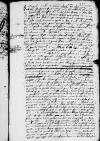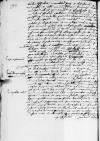Letter #1729
[Ioannes DANTISCUS] to [Johan WEZE]Löbau (Lubawa), 1537-09-28
English register: Dantiscus is replying to Weze’s letter. He apologizes for taking so long. The news received from Weze concerning Isabel (Delgada) has been confirmed in the letters of (Diego Gracián de Alderete) suitor of Dantiscus’ daughter (Juana Dantisca). Dantiscus is embittered at the lack of response to his proposals as to his daughter’s future, of which he informed Ehinger in a letter, so he has decided not to interfere with the course of events. He writes unfavorably of Gracián, about whom Albrecht Cuon wrote to him that he is proud and that he suffers from the French disease. He also suggests that Juana may not be his child. Dantiscus informs Weze that Prussian Prince Albrecht was present at the coronation of the prince of Holstein as king of Denmark, which took place in recent days in Copenhagen. The pestilence is spreading on the (Baltic) coast, so Albrecht was forced to return from the coronation by sea. The ceremonies were magnificent but, despite the hopes they raised, and knowing the nature of the Danes, Dantiscus does not believe in lasting peace in this region. Dantiscus thanks Weze for the news and states that the political situation has deteriorated substantially. He is particularly shocked at the news of the alliance between France and Turkey. He is also worried at the lack of news from Cornelis De Schepper. He states his wish (yet again) that the epitaph he wrote for Alfonso Valdes be placed in the church (where Valdes is buried in Vienna), especially since he has paid for a space on the wall. He criticizes the new custom of charging such a fee. Dantiscus would greatly like to see Weze again someday, and encourages him to write letters. He informs Weze about his election to the post of Warmia bishop. He hopes Weze will also be promoted to some major German or Spanish bishopric.
Manuscript sources:
Prints:
| ||||||||||||||||||
Text & apparatus & commentary Plain text Text & commentary Text & apparatus
Reverendissime Domine, Domine et Amice carissime ac observandissime. Salutem fraternique amoris mei commendationem plurimam.
Quod hucusque amicissimis Dominationis Vestrae cf.
Pro novis, quae Dominatio Vestra Reverendissima scripsit, magnam habeo gratiam. Interea immutata sunt plurima ut in infrascriptis lege, sed non in meliorem statum, cum
Quid hinc scribam earum rerum, quae hic aguntur, non habeo aliud, quam quod
Scripsi superioribus mensibus Dominationi Vestrae Reverendissimae, quidnam agat communis noster amicus dominus
Velim et  BCz, 244, p. 278
ecclesiae praefectis (inauditum prius et detestandum) ms 2 3 4 quinque,
BCz, 244, p. 278
ecclesiae praefectis (inauditum prius et detestandum) ms 2 3 4 quinque,
ms 1 quinq[ue] paper damaged⌈quinquems 2 3 4 quinque,
ms 1 quinq[ue] paper damaged⌉ vel septem, si recte memini, floreni Renenses. Si ms 2 3 4 tantum,
ms 1 tant[um] paper damaged⌈tantumms 2 3 4 tantum,
ms 1 tant[um] paper damaged⌉ accipitur ab iis, qui ornant, qu hidden by binding⌈[u]u hidden by binding⌉id ab iis, qui ms 2 3 4 cadaveribus,
ms 1 ca[da]veribus paper damaged⌈cadaveribusms 2 3 4 cadaveribus,
ms 1 ca[da]veribus paper damaged⌉ foedant ecclesiam? Recens, inquam superinscribed⌈inquaminquam superinscribed⌉, et novum est ms 2 3 4 prodigiosum,
ms 1 pro[di]giosum paper damaged⌈prodigiosumms 2 3 4 prodigiosum,
ms 1 pro[di]giosum paper damaged⌉, quod et tabellae parietes decorantes sine ms 2 3 4 pretio,
ms 1 pr[etio] paper damaged⌈pretioms 2 3 4 pretio,
ms 1 pr[etio] paper damaged⌉ non admittantur.[3]
Quod Dominatio Vestra Reverendissima in calce ms 2 3 4 litterarum,
ms 1 littera[rum] paper damaged⌈litterarumms 2 3 4 litterarum,
ms 1 littera[rum] paper damaged⌉ addit se desiderare, ut me aliquando videre possit, ms 2 3 4 idipsum,
ms 1 [id]ipsum paper damaged⌈idipsumms 2 3 4 idipsum,
ms 1 [id]ipsum paper damaged⌉ revera, quantum animus meus praegestit et adhuc, ms 2 3 4 antequam,
ms 1 a[ntequam] paper damaged⌈antequamms 2 3 4 antequam,
ms 1 a[ntequam] paper damaged⌉ e vivis migrem, ut superinscribed⌈utut superinscribed⌉ Dominationem Vestram Reverendissimam coram complecti
illamque ms 2 3 4 amicissime,
ms 1 a[mi]cissime paper damaged⌈amicissimems 2 3 4 amicissime,
ms 1 a[mi]cissime paper damaged⌉ familiarissimeque alloqui possim, scribi ms 2 3 4 nequit,
ms 1 neq[uit] paper damaged⌈nequitms 2 3 4 nequit,
ms 1 neq[uit] paper damaged⌉. Quod si aliquando contigerit,
cf. Hor. Carm. 1.1.36 sublimi feriam sidra vertice ⌊sublimi feriam vertice sideracf. Hor. Carm. 1.1.36 sublimi feriam sidra vertice ⌋,
ms 2 3 4 sin,
ms 1 [sin] paper damaged⌈sinms 2 3 4 sin,
ms 1 [sin] paper damaged⌉ minus, ut crebris litteris nos vicissim visitemus, pro ms 2 3 4 leniendo,
ms 1 le[nien]do paper damaged⌈leniendoms 2 3 4 leniendo,
ms 1 le[nien]do paper damaged⌉ utrimque desiderio nostro, utrisque erit incumbendum, ms 2 3 4 quibus,
ms 1 quib[us] paper damaged⌈quibusms 2 3 4 quibus,
ms 1 quib[us] paper damaged⌉
cf. Verg. A. 4. 83 illum absens absentem auditque, videtque; Adagia 1526 No. 1684 Praesens abest (-- contra qui amant, absentes praesentes sunt veluti de Didone Verg.: Absens absentem auditque videtque ⌊audiat on the margin⌈audiataudiat on the margin⌉ absentem absens audiat videatquecf. Verg. A. 4. 83 illum absens absentem auditque, videtque; Adagia 1526 No. 1684 Praesens abest (-- contra qui amant, absentes praesentes sunt veluti de Didone Verg.: Absens absentem auditque videtque ⌋
legendo.
ms 2 3 4 Qui,
ms 1 Qu[i] paper damaged⌈Quims 2 3 4 Qui,
ms 1 Qu[i] paper damaged⌉ diligit amicum, non potest non esse de fortunis eius ms 2 3 4 sollicitus,
ms 1 sol[li]citus paper damaged⌈sollicitusms 2 3 4 sollicitus,
ms 1 sol[li]citus paper damaged⌉, unde nihil foret mihi iucundius superinscribed in place of crossed-out gracius(?)⌈gracius(?)iucundiusiucundius superinscribed in place of crossed-out gracius(?)⌉, quam scire Dominationem Vestram ms 2 3 4 Reverendissimam,
ms 1 R[everendissimam] paper damaged⌈Reverendissimamms 2 3 4 Reverendissimam,
ms 1 R[everendissimam] paper damaged⌉ pro tot longis superinscribed⌈longislongis superinscribed⌉ duris et utilibus servitiis, quibus
ms 1 [iam] paper damaged⌈iamms 2 3 4 iam,
ms 1 [iam] paper damaged⌉ tot annis fuit usui, dignam compensationem on the margin in place of crossed-out recompensa(tionem)⌈recompensa(tionem)compensationemcompensationem on the margin in place of crossed-out recompensa(tionem)⌉ ms 2 3 4 remuneration[emque],
ms 1 remunerationemque⌈remunerationemque paper damaged⌈[emque]emque paper damaged⌉ms 2 3 4 remuneration[emque],
ms 1 remunerationemque⌉ re superinscribed in place of crossed-out per⌈perrere superinscribed in place of crossed-out per⌉cepisse. Pergratum itaque mihi Dominatio Vestra Reverendissima ms 2 3 4 fecerit,
ms 1 feceri[t] paper damaged⌈feceritms 2 3 4 fecerit,
ms 1 feceri[t] paper damaged⌉, si in eo me reddiderit certiorem. Quantum written over i⌈iumum written over i⌉ enim Dominationi Vestrae Reverendissimae pro meritis on the margin⌈pro meritispro meritis on the margin⌉ accesserit honoris et commodi, tantum et mihi ms 2 3 4 accrevisse,
ms 1 accre[vis]se paper damaged⌈accrevissems 2 3 4 accrevisse,
ms 1 accre[vis]se paper damaged⌉arbitrabor. Utinam
ms 2 3 4 maiestas⌈m(aies)tates paper damaged⌈[ates]ates paper damaged⌉ms 1 m(aies)t[ates],
ms 2 3 4 maiestas⌉
ms 3 haberent,
ms 4 haberet⌈habere(n)tms 1 2 habere(n)t,
ms 3 haberent,
ms 4 haberet⌉ rationem, quam de me serenissimus rex meus habet on the margin⌈
ms 1 [non] paper damaged⌈nonms 2 3 4 non,
ms 1 [non] paper damaged⌉ tam bene merito, quam written over ut⌈utquamquam written over ut⌉ de suis est principibus Dominatio Vestra ms 2 3 4 Reverendissima,
ms 1 R[everendissima] paper damaged⌈Reverendissimams 2 3 4 Reverendissima,
ms 1 R[everendissima] paper damaged⌉ bene merita – in alio, eminentiorique statu res vestrae ms 2 3 4 essent,
ms 1 es[sent] paper damaged⌈essentms 2 3 4 essent,
ms 1 es[sent] paper damaged⌉. Translatus siquidem sum, cum coadiutoriae negotium hidden by binding⌈[tium]tium hidden by binding⌉
ms 1 g[ratia] paper damaged⌈gratiams 2 3 4 gratia,
ms 1 g[ratia] paper damaged⌉
ms 1 pos[tu]lavit paper damaged⌈postulavitms 2 3 4 postulavit,
ms 1 pos[tu]lavit paper damaged⌉, habiturus ex Dei misericordia multo quam ms 2 3 4 prius,
ms 1 [prius] paper damaged⌈priusms 2 3 4 prius,
ms 1 [prius] paper damaged⌉ episcopatum (utinam cum animae meae salute) ms 2 3 4 opulentiorem,
ms 1 opulentiore[m] paper damaged⌈opulentioremms 2 3 4 opulentiorem,
ms 1 opulentiore[m] paper damaged⌉.
cf. Verg. A. 4. 12 Credo equidem, nec vana fides ⌊Spero quidem, nec vana fidescf. Verg. A. 4. 12 Credo equidem, nec vana fides ⌋,
brevi item superinscribed⌈itemitem superinscribed⌉ et Dominationem Vestram ms 2 3 4 Reverendissimam,
ms 1 R[everendissimam] paper damaged⌈Reverendissimamms 2 3 4 Reverendissimam,
ms 1 R[everendissimam] paper damaged⌉ vel apud
ms 1 aliq[uem] paper damaged⌈aliquemms 2 3 4 aliquem,
ms 1 aliq[uem] paper damaged⌉ episcopatum consecuturam. Quam diutissime bene ms 2 3 4 feliciterque,
ms 1 feliciter[que] paper damaged⌈feliciterquems 2 3 4 feliciterque,
ms 1 feliciter[que] paper damaged⌉ valere omnique honore et fortunis in dies ms 2 3 4 ornatioremque,
ms 1 ornatio[remque] paper damaged⌈ornatioremquems 2 3 4 ornatioremque,
ms 1 ornatio[remque] paper damaged⌉ fieri totis animi percupio ac aveo viribus.
Ex
ms 1 MDXXX[VII] paper damaged⌈MDXXXVIIms 2 3 4 MDXXXVII,
ms 1 MDXXX[VII] paper damaged⌉.

